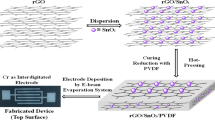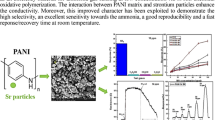Abstract
The development of smart sensors towards monitoring health and environmental has been receiving growing attention in the recent past. In particular, development of wearable, flexible, stretchable, and semitransparent sensors are desirable for modern technological applications. In this work, we present a simple strategy towards preparation of highly flexible and stretchable composite sensors based on poly (3,4-ethylenedioxythiophene: poly(styrene sulfonic acid)) (p-PEDOT–PSS) and titanium dioxide (n-TiO2) treated with diethylene Glycol (DEG) using a simple bar coating technique. The surface morphology, distribution of TiO2 nanoparticles, thermal stability, and various functional groups present in the composite were characterized by SEM, TEM, TGA, and FT-IR techniques. Presence of TiO2 and DEG treatment in PEDOT–PSS enhances the electrical conductivity (2 S/cm to 515 S/cm) and mechanical stability of the composite films. This ultra-sensitive, highly flexible, and stretchable thin layer of PEDOT–PSS:TiO2 treated with (DEG) was employed as a resistive sensor for the detection of Nitric Oxide (NO) (1–250 ppm) at room temperature. These ultra-sensitive nanocomposite films exhibit a sensitivity of 96% (@ 250 ppm) with excellent sensitivity retention under mechanical deformations such as bending and stretching. For the first time, this report presents the simultaneous determination of conductivity and NO-sensing performance of rolled and stretched sensing films based on conductive PEDOT–PSS composites. Owing to its low-cost fabrication, excellent conductivity, high sensitivity under mechanical deformations and long-term stability, the composite films studied in this work could potentially be used as a wearable and flexible gas sensor in organic electronics towards detection of NO gas.












Similar content being viewed by others
Change history
22 August 2023
This article has been retracted. Please see the Retraction Notice for more detail: https://doi.org/10.1007/s10854-023-11169-0
References
X.W. Cong, Air pollution from industrial waste gas emissions is associated with cancer incidences in Shanghai, China. Environ. Sci. Pollut. Res. 25(13), 13067 (2018)
Y.S. Yoo, A. Bhardwaj, J.W. Hong, H.N. Im, S.J. Song, Sensing performance of a YSZ-based electrochemical NO2 sensor using nanocomposite electrodes. J. Electrochem. Soc. 166(10), B799 (2019)
Y.C. Wong, B.C. Ang, A.S.M.A. Haseeb, A.A. Baharuddin, Y.H. Wong, Conducting polymers as chemiresistive gas sensing materials: a review. J. Electrochem. Soc. 167, 037503 (2020)
M.M. Arafat, A.S.M.A. Haseeb, S.A. Akbar, M.Z. Quadir, In-situ fabricated gas sensors based on one dimensional core-shell TiO2-Al2O3 nanostructures. Sens. Actuators B Chem. 238, 972 (2017)
N.M. Iverson, E.M. Hofferber, J.A. Stapleton, Nitric Oxide Sensors for Biological Applications. Chemosensors 6, 8 (2018)
A. Dey, Semiconductor metal oxide gas sensors: a review. Mater. Sci. Eng. B 229, 206–217 (2018)
C.M. Hangarter, N. Chartuprayoon, S.C. Hernandez, Y. Choa, N.V. Myung, Hybridized conducting polymer chemiresistive nano-sensors. Nano Today 8(1), 39 (2013)
Wu. Min-Ru, W.-Z. Li, C.-Y. Tung, C.-Y. Huang, Y.-H. Chiang, P.-L. Liu, R.-H. Horng, NO gas sensor based on ZnGa2O4 epilayer grown by metal organic chemical vapor deposition. Sci. Rep. 9, 7459 (2019)
Y.-T. Tsai, S.-J. Chang, L.-W. Ji, Y.-J. Hsiao, I.-T. Tang, H.-Y. Lu, Y.-L. Chu, High response of no gas sensors based on novel ag-doped ZnO nanoflowers enhanced with a UV light-emitting diode. ACS Omega 3, 13798–21380 (2018)
H.-Y. Li, Z.-X. Cai, J.-C. Ding, X. Guo, Gigantically enhanced NO sensing properties of WO3/SnO2 double layer sensors with Pd decoration. Sens Actuators B 220, 398–405 (2015)
M.D. Brown, M.H. Schoenfisch, Electrochemical nitric oxide sensors: principles of design and characterization. Chem. Rev. 119(22), 11551–11575 (2019)
X. Dang, Hu. Hui, S. Wang, Hu. Shengshui, Nanomaterials-based electrochemical sensors for nitric oxide. Microchim Acta 182, 455–467 (2015)
C. Sun, G. Maduraiveeran, P. Dutta, Nitric oxide sensors using combination of p- and n-type semiconducting oxides and its application for detecting NO in human breath. Sens. Actuators B: Chem. 186, 117–125 (2013)
Z.-X. Cai, H.-Y. Li, X.-N. Guo, NO sensing by single crystalline WO3 nanowires. Sens. Actuators B: Chem. 219, 346–353 (2015)
L.-Y. Hong, H.-N. Lin, NO gas sensing at room temperature using single titanium oxide nanodot sensors created by atomic force microscopy nanolithography. Beilstein J. Nanotechnol. 7, 1044–1051 (2016)
I. Fratoddi, I. Venditti, C. Cametti, M.V. Russo, Chemiresistive polyaniline-based gas sensors: a mini review. Sens. Actuators B: Chem. 220, 534–548 (2015)
S.L. Bai, J. Guo, J.H. Sun, P.G. Tang, A.F. Chen, R.X. Luo, D.Q. Li, Enhancement of NO2-sensing performance at room temperature by graphene-modified polythiophene. Ind. Eng. Chem. Res. 55(19), 5788 (2016)
H. Pang, Xu. Ling, D.-X. Yan, Z.-M. Li, Conductive polymer composites with segregated structures. Prog. Polym. Sci. 39(11), 1908–1933 (2014)
H. Malkeshi, H.M. Moghaddam, Self-assembly synthesis and ammonia gas-sensing properties of ZnO/polythiophene nanofibers. J. Polym. Res. 23(6), 8807–8815 (2016)
A. Sinha, R. Jain, Design, fabrication, and optimization of polypyrrole/bismuth oxide nanocomposite as voltammetric sensor for the electro-analysis of clofazimine. J. Electrochem. Soc. 165(14), H979 (2018)
A. Pasha, S. Khasim, O.A. Al-Hartomy, M. Lakshmi, K.G. Manjunatha, Highly sensitive ethylene glycol-doped PEDOT–PSS organic thin films for LPG sensing. RSC Adv. 8, 18074 (2018)
O.A. Al-Hartomy, S. Khasim, A. Roy, A. Pasha, Highly conductive polyaniline/graphene nano-platelet composite sensor towards detection of toluene and benzene gases. Appl. Phys. A 125, 12 (2019)
M. Zhang, H.L. Chen, H.R. Wang, Improved sensing properties of CO2 gas sensor based on Li3PO4-Li2SiO3 thin film compared with Li3PO4. J. Electrochem. Soc. 165(5), B167 (2018)
S.Q. Li, P.F. Lin, L.P. Zhao, C. Wang, D.Y. Liu, F.M. Liu, P. Sun, X.S. Liang, F.M. Liu, X. Yan, Y. Gao, G.Y. Lu, The room temperature gas sensor based on Polyaniline @ flower-like WO3 nanocomposites and flexible PET substrate for NH3 detection. Sens. Actuat B-Chem. 259, 505 (2018)
S. Khasim, O.A. Al-Hartomy, Fabrication and gas response in heterostructures of ortho-chloropolyaniline–ZnO nanocomposites. RSC Adv. 4, 39844 (2014)
J. Griffin, A.J. Ryan, D.G. Lidzey, Solution modification of PEDOT:PSS inks for ultrasonic spray coating. Org. Electron. 41, 245–250 (2017)
Y.K. Seo, C.W. Joo, J. Lee, J.W. Han, D.J. Lee, S. Aisyah, N. Entifa, S. Kim, N.S. Cho, Y. HyunKim, Enhanced electrical properties of PEDOT:PSS films using solvent treatment and its application to ITO-free organic light-emitting diodes. J. Lumin. 187, 221–226 (2017)
S. Rafique, S. MahAbdullah, M.M. Shahid, M.O. Ansari, K. Sulaiman, Significantly improved photovoltaic performance in polymer bulk heterojunction solar cells with graphene oxide /PEDOT:PSS double decked hole transport layer. Sci. Rep. 7, 39555 (2017)
L.V. Kayser, D.J. Lipomi, Stretchable conductive polymers and composites based on PEDOT and PEDOT:PSS. Adv. Mater. 31, 1806133 (2019)
G. Huseynova, Y.H. Kim, J.-H. Lee, J. Lee, Rising advancements in the application of PEDOT:PSS as a prosperous transparent and flexible electrode material for solution-processed organic electronics. J. Inf. Disp. 21(2), 71–91 (2020)
S. Khasim, A. Pasha, N. Badi, M. Lakshmi, Y.K. Mishra, High performance flexible supercapacitors based on secondary doped PEDOT–PSS–graphene nanocomposite films for large area solid state devices. RSC Adv. 10, 10526 (2020)
J.-Y. Kim, W. Lee, Y.H. Kang, S.Y. Cho, K.-S. Jang, Wet-spinning and post-treatment of CNT/PEDOT:PSS composites for use in organic fiber-based thermoelectric generators. Carbon 133, 293–299 (2018)
A. Pasha, S. Khasim, F.A. Khan, N. Dhananjaya, Fabrication of gas sensor device using poly (3,4-ethylenedioxythiophene)-poly (styrenesulfonate)-doped reduced graphene oxide organic thin films for detection of ammonia gas at room temperature. Iran. Polym. J. 28, 183–192 (2019)
Z. Li, A.A. Haidry, B. Gao, T. Wang, Z.J. Yao, The effect of Co-doping on the humidity sensing properties of ordered mesoporous TiO2. Appl. Surf. Sci 412, 638–647 (2017)
S. Khasim, A. Pasha, N. Badi, M. Lakshmi, S.A. Al-Ghamdi, H.A. AL-Aoh, PVA treated PEDOT–PSS:TiO2 nanocomposite based high-performance sensors towards detection of relative humidity and soil moisture content for agricultural applications. J. Polym. Environ. 29, 612–623 (2021)
Z. Li, Z.J. Yao, A.A. Haidry, T. Plecenik, L. Xie, L. Sun, Q. Fatima, Resistive-type hydrogen gas sensor based on TiO2: a review. Int. J. Hydrog. Energy 43, 21114–21132 (2018)
H.G. Pozos, K.T. Venkata Krishna, M. de la Luz Olvera Amador, Y. Kudriavtsev, A.M. Alvarez, TiO2 thin film based gas sensors for CO-detection. J. Mater. Sci.: Mater. Electron. 29, 15829–15837 (2018)
A.V. Raghu, K.K. Karuppanan, B. Pullithadathil, Controlled carbon doping in anatase TiO2 (101) facets: superior trace-level ethanol gas sensor performance and adsorption kinetics. Adv. Mater. Interfaces 6, 1801714 (2019)
M.T. Amiri, A.A. Ashkarran, Fabrication, characterization and enhanced sensing performance of graphene-TiO2 gas sensor device. J. Mater. Sci.: Mater. Electron. 28, 9435–9441 (2017)
S. Khasim, A. Pasha, A.S. Roy, A. Parveen, N. Badi, Effect of secondary doping using sorbitol on structure and transport properties of PEDOT–PSS thin films. J. Electron. Mater. 46(7), 4439–4447 (2017)
A. Pasha, A.S. Roy, M.V. Murugendrappa, O.A. Al-Hartomy, S. Khasim, Conductivity and dielectric properties of PEDOT–PSS doped DMSO nano composite thin films. J. Mater. Sci.: Mater. Electron. 27, 8332–8339 (2016)
Xi. Fan, W. Nie, H. Tsai, N. Wang, H. Huang, Y. Cheng, R. Wen, L. Ma, F. Yan, Y. Xia, PEDOT:PSS for flexible and stretchable electronics: modifications, strategies, and applications. Adv. Sci. 6, 1900813 (2019)
J.C. Costa, F. Spina, P. Lugoda, L. Garcia-Garcia, D. Roggen, N. Münzenrieder, Flexible sensors—from materials to applications. Technologies 7, 35 (2019)
X. Wei, L. Xiao, W. Huang, J. Liao, Z.D. Chen, Improving the performance and stability of flexible pressure sensors with an air gap structure. RSC Adv. 7, 48354 (2017)
M.N. Gueye, A. Carella, J. Faure-Vincent, R. Demadrille, J.-P. Simonato, Progress in understanding structure and transport properties of PEDOT-based materials: a critical review. Prog. Mater Sci. 108, 100616 (2020)
S. El-Sherbiny, F. Morsy, M. Samir, O.A. Fouad, Synthesis, characterization and application of TiO2 nano powders as special paper coating pigment. Appl Nanosci. 4, 305–313 (2014)
J. Ouyang, C.-W. Chu, F.-C. Chen, Q. Xu, Y. Yang, High-conductivity poly (3,4-ethylenedioxythiophene): poly (styrene sulfonate) film and its application in polymer optoelectronic devices. Adv. Funct. Mater. 15, 203 (2005)
A. Gusain, N.J. Joshi, P. Varde, D. Aswal, Flexible NO gas sensor based on conducting polymer poly [N-9′-heptadecanyl-2, 7-carbazole-alt-5, 5-(4′, 7′-di-2-thienyl-2′, 1′, 3′-benzothiadiazole)] (PCDTBT)”. Sens. Actuators B: Chem. 239, 734–745 (2017)
Y.H. Navale, S.T. Navale, N.S. Ramgir, F.J. Stadler, S.K. Gupta, D.K. Aswal, V.B. Patil, Zinc oxide hierarchical nanostructures as potential NO2 sensors. Sens. Actuators B 251, 551–563 (2017)
D. Liu, X. Ren, Y. Li, Z. Tang, Z. Zhang, Nanowires-assembled WO3 nanomesh for fast detection of ppb-level NO2 at low temperature. J. Adv. Ceram. 9(1), 17–26 (2020)
L.-Y. Hong, H.-W. Ke, C.-E. Tsai, H.-N. Lin, Low concentration NO gas sensing under ambient environment using Cu2O nanoparticle modified ZnO nanowires. Mater. Lett. 185, 243–246 (2016)
Acknowledgements
The authors would like to acknowledge financial support for this work, from the Deanship of Scientific research (DSR), University of Tabuk, Tabuk, Saudi Arabia, under Grant No. S-1440-0267.
Author information
Authors and Affiliations
Corresponding author
Additional information
Publisher's Note
Springer Nature remains neutral with regard to jurisdictional claims in published maps and institutional affiliations.
This article has been retracted. Please see the retraction notice for more detail: https://doi.org/10.1007/s10854-023-11169-0"
Rights and permissions
Springer Nature or its licensor (e.g. a society or other partner) holds exclusive rights to this article under a publishing agreement with the author(s) or other rightsholder(s); author self-archiving of the accepted manuscript version of this article is solely governed by the terms of such publishing agreement and applicable law.
About this article
Cite this article
Khasim, S., Pasha, A., Hatem-Al-Aoh et al. RETRACTED ARTICLE: Development of high-performance flexible and stretchable sensor based on secondary doped PEDOT–PSS:TiO2 nanocomposite for room-temperature detection of nitric oxide. J Mater Sci: Mater Electron 32, 7491–7508 (2021). https://doi.org/10.1007/s10854-021-05462-z
Received:
Accepted:
Published:
Issue Date:
DOI: https://doi.org/10.1007/s10854-021-05462-z




